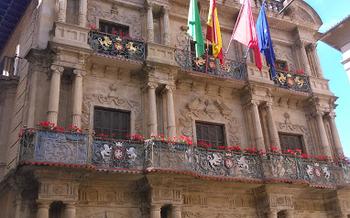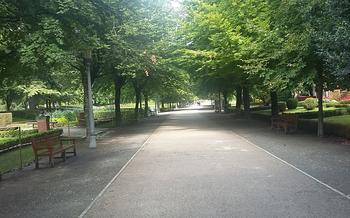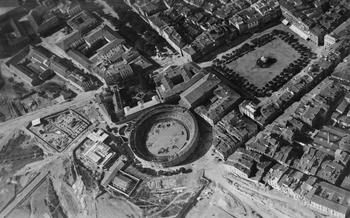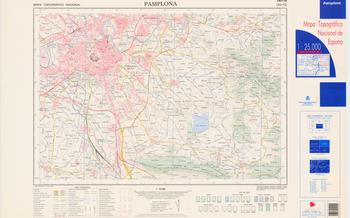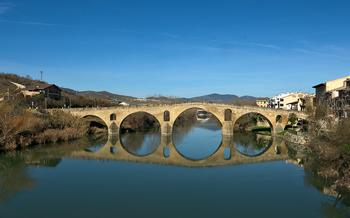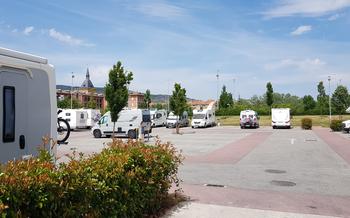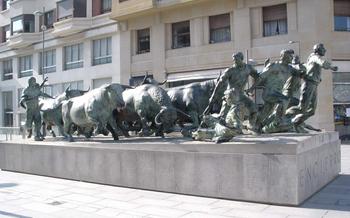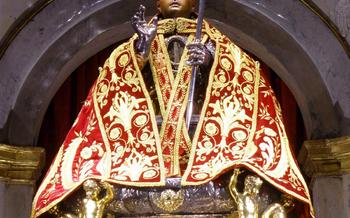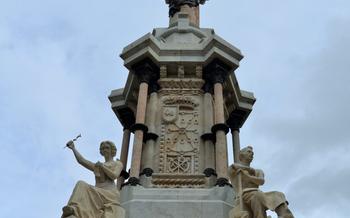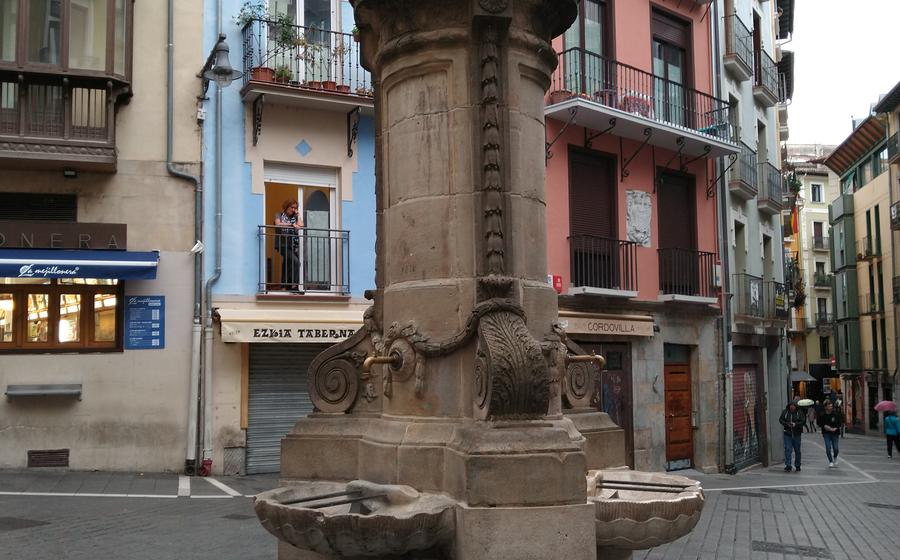
Fountain of Navarrería (Fuente de Navarrería)
- A Symbol of Pamplona's History
- Location and Accessibility: A Gateway to History and Beauty
- History and Construction: A Legacy of Craftsmanship and Civic Pride
- Artistic Features
- Renovation and Restoration
- Water Features and Symbolism
- Festivals and Celebrations: A Stage for Pamplona's Cultural Heritage
- Local Cuisine and Gastronomy
- Photography Opportunities
- Accessibility and Accommodations
- Sustainable Tourism Practices
A Symbol of Pamplona's History
The Fountain of Navarrería stands as a testament to Pamplona's rich past, deeply embedded in the city's identity. Built in the 17th century, it served as a vital water source for the city's inhabitants and became a meeting point for locals and travelers alike. Its unique architectural style, characterized by intricate carvings and reliefs, reflects the artistic and cultural heritage of Pamplona. The fountain's enduring presence has made it a beloved landmark, symbolizing the city's resilience and its deep connection to its history.
Location and Accessibility: A Gateway to History and Beauty
The Fountain of Navarrería stands proudly in the heart of Pamplona, at the confluence of Plaza Consistorial and Calle Navarrería. Its strategic location makes it a natural meeting point for locals and tourists alike. The fountain's proximity to other notable landmarks, such as the City Hall, the Cathedral of Santa María la Real, and the Plaza del Castillo, invites visitors to explore the city's rich heritage and diverse attractions.
Reaching the fountain is a breeze, with multiple public transportation options available. Several bus lines stop nearby, and the Plaza del Castillo metro station is just a short walk away. For those who prefer to stroll along the charming streets of Pamplona, the fountain is easily accessible on foot from the city center. Immerse yourself in the city's vibrant atmosphere as you wander through its narrow alleys and bustling squares, leading you to this iconic landmark.
History and Construction: A Legacy of Craftsmanship and Civic Pride
Standing tall as a symbol of Pamplona's rich past, the Fountain of Navarrería boasts a fascinating history that dates back to the 14th century. Originally conceived as a water supply for the city's growing population, the fountain's construction was initiated in 1390 under the patronage of King Charles III of Navarre. The project was funded by the city council and overseen by a team of skilled craftsmen who dedicated years to its intricate design and construction.
Throughout the centuries, the fountain underwent several modifications and renovations, reflecting the evolving tastes and needs of Pamplona's inhabitants. In the 17th century, the fountain was adorned with elegant sculptures and reliefs by local artists, further enhancing its artistic and cultural significance. These intricate carvings depict mythical creatures, biblical scenes, and allegorical figures, each narrating a unique chapter in the city's history.
One of the most captivating anecdotes associated with the fountain's construction revolves around a local legend. It is said that the fountain's architect, upon completing his masterpiece, fell into a deep sleep beneath its shadow. When he awoke, he discovered that his plans had been stolen, and in a fit of despair, he leaped into the fountain, never to be seen again. This tragic tale adds a touch of mystery and intrigue to the fountain's allure, forever etching its mark in the annals of Pamplona's folklore.
Artistic Features
The Fountain of Navarrería is a captivating work of art, showcasing a harmonious blend of architectural styles and intricate details. Its overall design exudes a sense of grandeur and elegance, with its towering structure adorned with a variety of symbolic elements and iconography. The fountain's central figure is a majestic sculpture of Neptune, the Roman god of the sea, standing proudly atop a plinth surrounded by four smaller figures representing the four seasons. These sculptures are exquisitely crafted, capturing the essence of each season through their postures and attributes.
Around the fountain's perimeter, a series of bas-reliefs depict scenes from mythology and history, narrating stories of love, betrayal, and heroism. These intricate carvings add depth and dimension to the fountain, inviting viewers to explore the rich tapestry of tales woven into its design. The fountain's base is adorned with a frieze of cherubs and garlands, adding a touch of playfulness and charm to the overall composition.
The artistic influences on the Fountain of Navarrería are diverse, reflecting the cultural heritage of Pamplona and the broader region. Elements of Romanesque, Gothic, and Renaissance styles can be discerned in its architecture, while the sculptures and reliefs exhibit a strong classical influence. The fountain's unique blend of styles and iconography creates a visually stunning masterpiece that has captivated visitors for centuries.
Renovation and Restoration
In the early 20th century, the Fountain of Navarrería underwent a significant renovation project to restore its original glory and preserve its cultural heritage. The restoration process required meticulous attention to detail, as the goal was to maintain the fountain's authenticity while addressing the effects of time and weathering. Skilled craftsmen and artisans employed traditional techniques to repair damaged elements, clean and polish the surfaces, and reinforce the structure.
The restoration also involved addressing the fountain's water system, ensuring that the flow of water remained consistent and visually appealing. To achieve this, modern engineering solutions were integrated while respecting the fountain's historic design. The project required careful coordination between historians, architects, and engineers to strike a balance between preservation and functionality.
Funding for the restoration came from a combination of public and private sources, demonstrating the community's commitment to preserving this iconic landmark. The successful completion of the renovation project ensured that the Fountain of Navarrería would continue to serve as a symbol of Pamplona's rich history and cultural identity for generations to come.
Water Features and Symbolism
The Fountain of Navarrería is not just a decorative landmark but also a functional water feature. Its water system, meticulously designed and maintained, ensures a continuous flow of fresh water that adds to the fountain's charm and symbolism. In many cultures, water holds profound significance, representing life, purity, and renewal. For Pamplona, the fountain symbolizes the city's connection to its water supply, a precious resource that has played a crucial role in its history and development. The gentle flow of water from the fountain serves as a reminder of the importance of water conservation and its vital role in sustaining the city and its people.
Festivals and Celebrations: A Stage for Pamplona's Cultural Heritage
Standing as a proud symbol of Pamplona's identity, the Fountain of Navarrería takes center stage during the city's vibrant festivals. The most renowned of these is San Fermín, a world-famous celebration that transforms the city into a sea of red and white. During this exhilarating fiesta, the fountain becomes a focal point, adorned with colorful decorations, twinkling lights, and the infectious energy of revelers.
Throughout the festival, the plaza surrounding the fountain buzzes with activity. Locals and visitors alike gather to witness traditional Basque dances, listen to live music, and indulge in the contagious spirit of San Fermín. The fountain serves as a backdrop for parades, performances, and the iconic running of the bulls, creating a mesmerizing spectacle that captivates all who behold it.
Beyond San Fermín, the fountain also plays a significant role in other local celebrations. During the Day of the Virgen del Camino, the fountain is adorned with flowers and candles, while on Three Kings Day, it becomes a stage for colorful processions and gift-giving ceremonies. These festivals showcase the rich cultural heritage of Pamplona, and the fountain stands as a testament to the city's enduring traditions.
Whether you're a seasoned festival-goer or a first-time visitor, experiencing the Fountain of Navarrería during Pamplona's celebrations is an unforgettable adventure. Immerse yourself in the vibrant atmosphere, let the rhythm of the music carry you away, and witness the city's rich cultural tapestry come alive against the backdrop of this iconic landmark.
Local Cuisine and Gastronomy
When visiting the Fountain of Navarrería, take the opportunity to explore the culinary delights of Pamplona. The surrounding area offers a variety of restaurants and cafes, each showcasing the region's rich gastronomy. Indulge in traditional dishes like the flavorful "pinchos," small tapas served on skewers, or savor the hearty "cocido navarro," a stew made with chickpeas, vegetables, and meats. For a taste of local flavors, try the "chistorra," a thin sausage grilled to perfection. Pair your meal with a glass of wine from the Navarra region, known for its exceptional quality. As you dine, soak in the vibrant atmosphere of the plaza, where the fountain serves as a backdrop to the city's culinary scene. Consider visiting the nearby San Miguel Market, a bustling indoor market offering a diverse selection of local produce, cheeses, and cured meats. Whether you choose to dine at a traditional restaurant or grab a bite at a food stall, the Fountain of Navarrería provides the perfect setting to savor the culinary treasures of Pamplona.
Photography Opportunities
The Fountain of Navarrería presents a picturesque subject for photography enthusiasts. With its intricate carvings, flowing water, and historical backdrop, the fountain offers a variety of angles and perspectives for capturing stunning images. For the best results, consider the following tips:
-
Golden Hour Magic: Aim to visit the fountain during the golden hours, shortly after sunrise or before sunset, when the warm, diffused light casts a magical glow on the fountain and its surroundings.
-
Experiment with Angles: Don't limit yourself to frontal shots. Try capturing the fountain from creative angles, such as from the side or from an elevated vantage point, to create depth and dynamism in your photos.
-
Focus on Details: Zoom in on the fountain's intricate carvings, sculptures, and reliefs to capture their unique beauty and symbolism. These details often go unnoticed but add depth and character to your photographs.
-
Incorporate the Surroundings: Photograph the fountain within the context of its surroundings, including the lively plaza, the surrounding architecture, and the bustling city life. This approach provides a sense of place and tells a story about the fountain's role in Pamplona's urban fabric.
Accessibility and Accommodations
The Fountain of Navarrería is committed to providing an inclusive and accessible experience for all visitors. Wheelchair ramps and tactile signage are available to ensure easy navigation for visitors with disabilities. Audio guides are also provided for a more immersive and comprehensive experience.
For travelers seeking accommodations, a range of options is available near the fountain. From budget-friendly hostels to luxurious hotels, visitors can choose a place that suits their preferences and needs. Accessible hotels and apartments are also available for those with special requirements.
To enhance the experience further, accessible tours or services can be arranged for visitors with disabilities. These tours provide tailored assistance and ensure that everyone can fully appreciate the fountain's beauty and historical significance.
Sustainable Tourism Practices
As you explore the Fountain of Navarrería and its surroundings, embrace responsible tourism practices to preserve its heritage and the environment. Respect the fountain's historical significance and its role in the community. Avoid littering or damaging the fountain or its surroundings. When possible, opt for eco-friendly transportation options to minimize your carbon footprint. Support local businesses that prioritize sustainability, such as restaurants using locally sourced ingredients or shops offering eco-friendly products. By embracing sustainable practices, you contribute to the preservation of Pamplona's cultural treasures while ensuring a harmonious coexistence between tourism and the environment.
